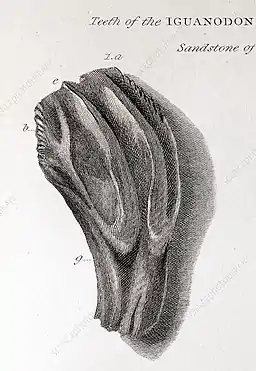Mary Ann Mantell
Mary Ann Mantell (née Woodhouse; April 9, 1795[1] – October 20, 1869[2]) was a British paleontologist. She is credited with the discovery of the first fossils of Iguanodon and provided several pen and ink sketches of the fossils for her husband, Gideon Mantell's, scientific description of the Iguanodon.[3]
Mary Ann Mantell | |
|---|---|
 | |
| Born | Mary Ann Woodhouse April 9th, 1795 Paddington, London, United Kingdom |
| Died | October 20th, 1869 |
| Occupation | Palaeontologist |
| Known for | Discovering Iguanodon |
| Spouse(s) | Gideon Mantell |
| Relatives | Walter Mantell (son) George Edward Woodhouse (father) Mary Ann Woodhouse (mother) |
Iguanodon discovery

In 1822, while Mary Ann Mantell was accompanying her husband in Sussex as he was visiting a patient, she discovered large tooth-shaped fossils on the side of the road. She presented these fossils to him. Her husband then proceeded to send Mary’s findings to Georges Cuvier,[4] who then initially thought the teeth that were sent to him were from a rhinoceros.[5] Cuvier also believed the teeth compared to those of a porcupine fish or a pufferfish; which resembled the Diodon and Tetraodon respectively.[3] Due to his excitement of her findings he launched an excavation of the Tilgate Forest, which resulted in the discovery of the herbivorous reptile, the Iguanodon.[3][6] The discovery of this fossil is known to be the first evidence of a prehistoric reptilian dinosaur, dating back roughly 130 million years ago.[7]
Impact on Paleontology
Mary Ann Mantell drew up 364 fine lithographs of the fossils, that were then used in her husband's scientific publication The Fossils of the South Downs published in 1822, and in Illustrations of the Geology of Sussex published in 1827, in which Gideon Mantell describes the Iguanodon, thus named due to its likeness to the modern day Iguana.[3][6] The discovery of the Iguanodon caused excitement amongst paleontologists it was the second largest reptile fossil to be discovered and the teeth of the Iguanodon suggested that the large reptile was an herbivore; whilst many believed that all ancestors of reptiles were carnivores, like the Megalosaurus,[8] discovered by William Buckland, in 1676.

Family life
Mary Ann Woodhouse was born on April 9, 1795 to George Edward Woodhouse and Mary Ann Woodhouse.[9] In 1816 she married Gideon Mantell and lived with him in Lewes. She accompanied Mantell on his fossil collection trips. Although the couple became a coherent research team, their personal lives suffered and the pair became increasingly distant causing their marriage to end in divorce. They had three children together, including prominent New Zealand scientist and politician Walter Mantell.[10] Gideon was the primary caretaker of the children after the divorce was finalized; he died in 1852 of an opium overdose.[11]
References
| Wikimedia Commons has media related to The Fossils of South Downs Or Illustrations of the Geology of Sussex. |
- BUREK, C. V. & HIGGS, B. (eds) The Role of Women in the History of Geology. Geological Society, London, Special Publications, 281, 1–8. DOI: 10.1144/SP281.1.
- "England and Wales National Probate Calendar 1858-1966]".
- "Dinosaur History". Brooklyn College City University of New York. Retrieved 20 September 2015.
- Georges Cuvier
- BUREK, C. V. & HIGGS, B. (eds) The Role of Women in the History of Geology. Geological Society, London, Special Publications, 281, 1–8. DOI: 10.1144/SP281.1.
- Mantell, Gideon (1827). Illustrations of the Geology of Sussex. London: Lupton Relfe. pp. 71–78 – via Books.Google.
- "Female fossil hunters: Mary Ann Mantell, Mary Anning, and Joan Wiffen". Te Papa’s Blog. 12 October 2018. Retrieved 2 October 2020.
- http://academic.brooklyn.cuny.edu/geology/chamber/mantell.html
- Turner, Susan; Burek, Cynthia V.; Moody, Richard T. J. (2010). "Forgotten women in an extinct saurian (man's) world". Geological Society, London, Special Publications. 343 (1): 111–153. Bibcode:2010GSLSP.343..111T. doi:10.1144/sp343.7. ISSN 0305-8719. S2CID 130338204.
- Marilyn Bailey Ogilvie, Joy Dorothy Harvey (2000). The Biographical Dictionary of Women in Science: L-Z. Taylor & Francis. p. 837. ISBN 041592040X.CS1 maint: uses authors parameter (link)
- BUREK, C. V. & HIGGS, B. (eds) The Role of Women in the History of Geology. Geological Society, London, Special Publications, 281, 1–8. DOI: 10.1144/SP281.1.
.
- "The Discovery of the Iguanodon". Natural History Museum. Retrieved 16 December 2020.